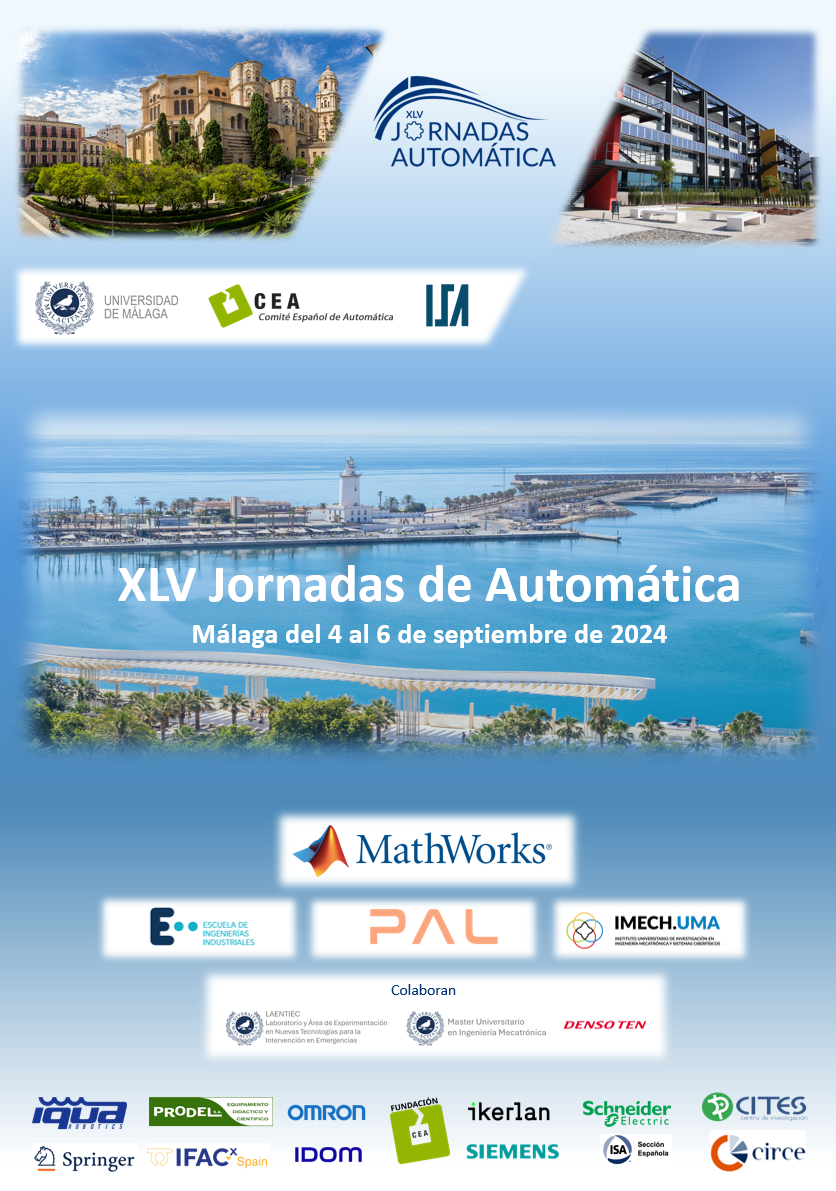Dispositivo háptico para la rehabilitación de dedo
Estudio preliminar
DOI:
https://doi.org/10.17979/ja-cea.2024.45.10823Palabras clave:
Control adaptativo, Control en tiempo real, Ingeniería de rehabilitación y prestación de servicios de salud, Robótica, Tecnología asistida e ingeniería de rehabilitaciónResumen
La rehabilitación es crucial para pacientes que han sufrido un accidente cerebrovascular. En este ámbito, los sistemas robóticos posibilitan ejercicios repetitivos y precisos, esenciales para la recuperación motora. RobHand, un exoesqueleto de mano desarrollado por el Instituto de Tecnologías Avanzadas de la Producción de la Universidad de Valladolid, permite la realización de terapias pasivas y bilaterales, asistiendo la flexión y extensión individual de los dedos. No obstante, para superar las limitaciones de los servomotores actuales, se propone sustituirlos por motores lineales LM2070-040-11 de Faulhaber, que destacan por su alta calidad, precisión y backdrivability. Presentamos un estudio preliminar de la implementación de un control de impedancia y un algoritmo de asistencia a medida utilizando estos nuevos motores lineales. Aunque este estudio se focaliza en un dedo, su aplicación es extrapolable a toda la mano. Los resultados muestran que esta actualización mejoraría significativamente el sistema.
Referencias
Barria, P., Riquelme, M., Reppich, H., Cisnal, A., Fraile, J.C., Pérez-Turiel, J., Sierra, D., Aguilar, R., Andrade, A., Nuñez-Espinosa, C., 2023. Hand rehabilitation based on the RobHand exoskeleton in stroke patients: A case series study. Front. Robot. AI 10, 1146018. DOI: 10.3389/frobt.2023.1146018.
Cisnal, A., Lobo, V., Moreno, V., Fraile, J.C., 2018. RobHand, un Exoesqueleto de Mano para la Rehabilitación Neuromotora Aplicando Terapias Activas y Pasivas, XXXIX Jornadas de Automática, Badajoz 34-4. DOI: 10.17979/spudc.9788497497565.0034.
Cisnal, A., Pérez-Turiel, J., Fraile, J. -C., Sierra, D., de la Fuente, E., 2021. RobHand: A Hand Exoskeleton With Real-Time EMG-Driven Embedded Control. Quantifying Hand Gesture Recognition Delays for Bilateral Rehabilitation. IEEE Access 9, 137809-137823. DOI: 10.1109/ACCESS.2021.3118281.
Cisnal, A., Moreno-SanJuan, V., Fraile, J.C., Turiel, J.P., de-la-Fuente, E., Sánchez-Brizuela, G., 2022. Assessment of the Patient’s Emotional Response with the RobHand Rehabilitation Platform: A Case Series Study. Journal of Clinical Medicine 11 15, 4442. DOI: 10.3390/jcm11154442.
Cisnal, A., Alonso-Linaje, G., Fraile, J.C., Pérez-Turiel, J., Álvarez, P., Martinez, S., 2024. Tackling Post-COVID-19 Rehabilitation Challenges: A Pilot Clinical Trial Investigating the Role of Robotic-Assisted Hand Rehabilitation. Journal of Clinical Medicine 13 6, 1543. DOI: 10.3390/jcm13061543.
Corbetta, D., Imeri, F., Gatti, R., 2015. Rehabilitation that incorporates virtual reality is more effective than standard rehabilitation for improving walking speed, balance and mobility after stroke: a systematic review. Journal of Physiotherapy 61, 117–124. DOI: 10.1016/J.JPHYS.2015.05.017
Feigin, V.L., Brainin, M., Norrving, B., Martins, S., Sacco, R.L., Hacke, W., Fisher, M., Pandian, J., Lindsay, P., 2022. World Stroke Organization (WSO): Global Stroke Fact Sheet 2022. International Journal of Stroke 17 1, 18-29. DOI: 10.1177/17474930211065917.
Kwakkel. G., Kollen, B. T. J., 2006. Impact of Time on Improvement of Outcome After Stroke. Stroke 37, 2348-2353. DOI: 10.1161/01.STR.0000238594.91938.1e.
Langhorne, P., Bernhardt, J., Kwakkel, G., 2011. Stroke Rehabilitation. The Lancet 377, 9778, 1693-1702. DOI: 10.1016/S0140-6736(11)60325-5.
Langhorne, P., Wagenaar, R., Partridge, C., 1996. Physiotherapy after stroke: More is better?. Physiotherapy Research International 1, 2, 75-88. DOI: 1996;1(2):75-88. doi: 10.1002/pri.6120010204.
Maier, M., Ballester, B.R., Verschure, P.F.M.J., 2019. Principles of Neurorehabilitation After Stroke Based on Motor Learning and Brain Plasticity Mechanisms. Frontiers in Systems Neuroscience 13, 1–18. DOI: 10.3389/fnsys.2019.00074.
Mihelj, M., Podobnik, J., 2013. Haptics for Virtual Reality and Teleoperation. Springer Dordrecht. DOI: 10.1007/978-94-007-5718-9.
Moreno-SanJuan, V., Cisnal, A., Fraile, J.C., Pérez-Turiel, J., de-la-Fuente, E., 2021. Design and characterization of a lightweight underactuated RACA hand exoskeleton for neurorehabilitation. Robotics and Autonomous Systems 143, 103828. DOI: 10.1016/j.robot.2021.103828.
Selzer, M., Clarke, S., Cohen, L., Kwakkel, G., Miller, R., 2014. Introduction to Neural Repair and Rehabilitation. In Textbook of Neural Repair and Rehabilitation. Cambridge University Press, Cambridge, pp. 18-24
Sierra, D., Sánchez Brizuela, G., Pérez-Turiel, J., Fraile, J.C., 2022. Control de exoesqueleto de rehabilitación de mano con Leap Motion Controller, XLIII Jornadas de Automática, 141-147. DOI: 10.17979/spudc.9788497498418.0141
van Meijeren-Pont, W., Tamminga, S.J., Goossens, P.H., Groeneveld, I.F., Arwert, H., Meesters, J.J.L., Mishre, R.R., Vlieland, T.P.M., van den Hout, W.B., 2021. The Stroke Cohort Outcomes of Rehabilitation (SCORE) study group. Societal burden of stroke rehabilitation: Costs and health outcomes after admission to stroke rehabilitation. Journal of Rehabilitation Medicine 53 6. DOI: 10.2340/16501977-2829.
Welmer, A.-K., Holmqvist, L. W., Sommerfeld, D. K., 2008. Limited fine hand use after stroke and its association with other disabilities. Journal of Rehabilitation Medicine 40 8, 603-608. DOI: 10.2340/16501977-0218.
Descargas
Publicado
Número
Sección
Licencia
Derechos de autor 2024 Diego Almendro, Ana Cisnal, Javier Pérez Turiel, Juan Carlos Fraile

Esta obra está bajo una licencia internacional Creative Commons Atribución-NoComercial-CompartirIgual 4.0.





